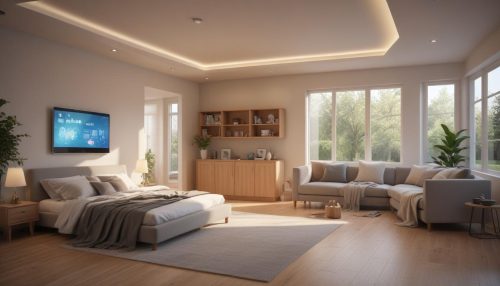How Smart Home Devices Change the Way You Live
Olivia Morgan August 20, 2025
Curious about bringing technology into your living space? This guide explores how smart home devices transforming our living, boost efficiency, and improve your home experience. Discover the benefits, privacy tips, and real-world uses of intelligent devices integrated into homes.
What Are Smart Home Devices and Why Do People Use Them
Smart home devices are rapidly changing the way homes function, offering features from energy management to hands-free convenience. These intelligent gadgets—like smart thermostats, lighting systems, security cameras, and voice assistants—connect to Wi-Fi networks and can be controlled via smartphones or spoken commands. Many households turn to smart home automation to simplify recurring tasks, save time, and improve comfort. Voice-controlled assistants, for example, let users adjust lighting, manage music, or set reminders without even touching a switch, contributing to a seamless lifestyle.
One of the main appeals of smart home devices is energy efficiency. Products like smart thermostats monitor usage patterns and automatically adjust heating and cooling, helping manage energy bills and environmental footprint. Smart lighting systems similarly adjust brightness or turn off when a room is unoccupied. Integration with energy management systems makes these features especially attractive to residents seeking responsible living and potential cost savings over time (Source: https://www.energy.gov/energysaver/articles/smart-home-technologies).
Security is another driving factor behind adoption. Smart doorbells and connected cameras provide real-time monitoring, instant alerts, and can even detect package deliveries. Many options feature two-way audio, allowing users to interact with visitors remotely. Automated door locks and alarm systems add another layer of protection, often integrated into a broader home security ecosystem for streamlined control, enhancing peace of mind for homeowners (Source: https://www.cisa.gov/news-events/news/secure-your-smart-home).
Popular Types of Smart Home Devices and Their Functions
The market offers a wide variety of smart home devices tailored to different needs. Smart speakers and voice assistants are frequently the central control point. These devices use artificial intelligence to handle requests, answer questions, and manage other connected gadgets throughout the home. Integration with home automation platforms is routine, making it possible to orchestrate entire household routines with a single voice command or app tap.
Smart lighting systems and bulbs are among the easiest upgrades, allowing residents to create schedules, adjust brightness, or set color tones. Automated schedules help reinforce healthy circadian rhythms and reduce energy waste. Advanced options sync lights with sunrise, sunset, or user activities—ideal for enhancing ambiance and safety. Many users also experiment with smart plugs, which convert ordinary appliances into intelligent, remotely controllable devices (Source: https://www.epa.gov/greenhomes/smart-homes).
Home security continues to dominate the home automation conversation. From video doorbells monitoring entryways to motion sensors and wireless cameras, homeowners can keep track of activity and receive alerts on their smartphones. These tools provide control even when occupants are away, making it easy to monitor children, pets, or deliveries in real-time. Many security systems pair with local emergency responses, improving situational awareness and response times (Source: https://www.consumerreports.org/home-garden/home-security/best-diy-home-security-systems-a5521489615/).
Benefits and Challenges of Integrating Smart Technology in the Home
One of the standout advantages of smart home technology is convenience. Automated routines mean lights dim for bedtime, thermostats adjust based on weather, and coffee makers start before residents wake. For individuals with disabilities or mobility concerns, these systems can be empowering—offering voice or app control to manage essential comforts and daily routines without physical effort (Source: https://www.ada.gov/resources/smart-home-accessibility/).
Energy management continues to drive interest. Smart thermostats, power strips, and sensors track patterns and optimize usage, promoting cost savings and supporting sustainable living. Water sensors, for example, can detect leaks and send alerts, potentially preventing serious property damage. These proactive and predictive features are changing the way people think about household operations and preventative maintenance.
Despite the advantages, challenges include initial setup complexity, interoperability issues, and privacy concerns. Not all devices from different brands communicate seamlessly, sometimes requiring homeowners to invest in additional hubs or platforms. Privacy is another issue, as smart devices collect data on habits and routines. Choosing reputable brands, managing permissions, and updating firmware regularly are key steps in reducing risks (Source: https://consumer.ftc.gov/articles/how-secure-your-home-smart-devices).
How to Get Started with a Smart Home Setup
Start by identifying home automation priorities: Do you want efficient lighting, enhanced security, climate control, or entertainment upgrades? Many homeowners begin their journey with a simple smart speaker or plug, gradually adding lighting, security, and energy management tools as confidence grows. Compatibility with existing Wi-Fi, phone operating systems, and household routines is an important consideration for maximizing utility and future expandability.
When setting up, carefully follow manufacturer instructions and use official applications to link devices. Securing the home network, using strong passwords, and enabling two-factor authentication protect against unauthorized access. Consider using a central platform like Google Home or Amazon Alexa for easy device synchronization, ensuring different brands work together as smoothly as possible. Planning ahead reduces frustration during expansion (Source: https://www.nist.gov/news-events/news/2019/08/smart-homes-are-future-make-them-secure).
Setup guides and community forums offer valuable troubleshooting advice and practical tips from real-world users. For particularly complex projects, consider consulting with certified smart home specialists who can recommend tailored devices, create automation routines, and help ensure both security and usability. Local utility companies and technology retailers increasingly offer workshops or toolkits to guide first-time users through the basics of home technology adoption.
Emerging Trends and What to Expect Next in Smart Homes
As technology evolves, expect increased interoperability, energy modeling, and integration with broader “Internet of Things” (IoT) ecosystems. Upcoming smart home devices may offer even more predictive automation, learning user habits to reduce manual input further. For example, advanced thermostats will diagnose inefficiencies and recommend quick fixes, while smart fridges will monitor expiration dates and suggest recipes that minimize food waste (Source: https://www.nrel.gov/news/program/2018/energy-smart-home-future.html).
Artificial Intelligence is increasingly central to smart home functions, supporting natural conversations, real-time translation, and intuitive gesture or voice control. Sensors embedded throughout homes will facilitate even better security and safety automations beyond current standards. Connectivity improvements, such as 5G and Wi-Fi 6, promise faster response times and more seamless device integration.
Privacy and data transparency initiatives are on the rise. Manufacturers are offering clearer data-use policies, and governments are implementing new regulations to protect personal information. Consumers can expect more tools for tracking, deleting, or managing the information that smart devices collect. Staying informed about these developments will help households benefit from the latest innovations while maintaining digital safety.
References
1. U.S. Department of Energy. (2022). Smart Home Technologies. Retrieved from https://www.energy.gov/energysaver/articles/smart-home-technologies
2. Cybersecurity & Infrastructure Security Agency (CISA). (2023). Secure Your Smart Home. Retrieved from https://www.cisa.gov/news-events/news/secure-your-smart-home
3. United States Environmental Protection Agency. (2020). Smart Homes. Retrieved from https://www.epa.gov/greenhomes/smart-homes
4. Consumer Reports. (2022). Best DIY Home Security Systems. Retrieved from https://www.consumerreports.org/home-garden/home-security/best-diy-home-security-systems-a5521489615/
5. Federal Trade Commission. (2022). How to Secure Your Home Smart Devices. Retrieved from https://consumer.ftc.gov/articles/how-secure-your-home-smart-devices
6. National Renewable Energy Laboratory. (2018). The Energy-Smart Home of the Future. Retrieved from https://www.nrel.gov/news/program/2018/energy-smart-home-future.html





